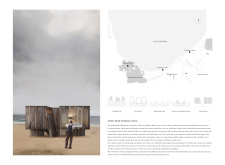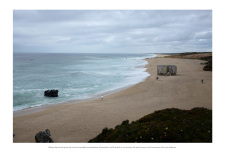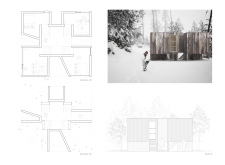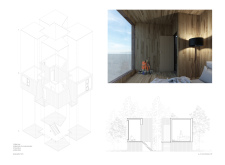5 key facts about this project
# Analytical Report on the Amber Road Trekking Cabins Architectural Design Project
## Project Overview
Located along the Latvia-Lithuania border, the Amber Road Trekking Cabins project aims to enhance the trekking experience in a region rich in cultural and natural diversity. The initiative focuses on creating accommodations that blend functionality, comfort, and aesthetic coherence with the surrounding landscapes. The cabins are strategically positioned to offer trekkers a safe and mosquito-free respite as they explore the scenic environment.
## Spatial Strategy
The design employs a modular approach, comprising multiple interconnected units that function as independent living spaces, accommodating groups of up to four individuals. This spatial arrangement promotes both privacy and community interaction, allowing guests to rest and rejuvenate together. The careful configuration aligns with the terrain, optimizing integration with the natural landscape and enriching the overall hiking experience.
## Material Selection and Environmental Integration
The choice of materials is a fundamental aspect of the design, with a predominant use of locally sourced wood that complements the environment and reflects the area's rural heritage. The natural wooden façade of the cabins harmonizes with the coastal scenery, effectively camouflaging the structures. This approach not only supports sustainability but also ensures durability against the region's climatic challenges, such as coastal winds and heavy rainfall.
The cabins incorporate several distinctive features aimed at enhancing user experience. Sustainable ventilation is achieved through strategically placed atrium spaces that facilitate natural airflow, improving indoor climate while offering views of the surrounding landscape. Additionally, the modular design allows for variations in spatial configuration based on site-specific conditions, ensuring both adaptability and functionality. Large windows maximize natural light, creating bright, inviting interiors that foster a strong connection between occupants and their natural surroundings. Each cabin layout includes essential amenities for a comfortable stay, while the design minimizes excavation to reduce environmental impact.
In summary, the Amber Road Trekking Cabins project exemplifies a well-conceived architectural response to its geographical context. The careful curation of materials and spatial dynamics emphasizes a commitment to sustainability and user experience, offering an innovative model for eco-friendly tourism in the region.





















































